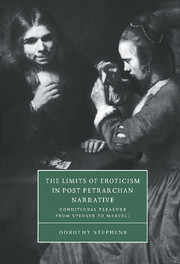Book contents
3 - Monstrous intimacy and arrested developments
Published online by Cambridge University Press: 22 September 2009
Summary
The previous chapter argued that Spenser allies himself with feminine fantasies that resemble the “nothing seene” of Greville's sonnet, the “newes of devils” produced by a deluded mind. It argued further that Spenser associates the poet's enchanting phrases with those of a bumbling old woman “set at nought”: Glauce, who for a moment provisionally takes on the fantastic powers of both Orpheus the singer and Allecto, Virgil's fire–hurling Fury. I want to move from that discussion of feminine fantasy to a more specific investigation of the relationship between feminine monstrosity and the spellbinding powers of Spenser's poem. Susanne Wofford has written that The Faerie Queene contains many examples of “displacement onto a demonized woman of precisely the principle that generates the narrative” (Choice, 290). The notion of conditionality can enlarge our understanding of this phenomenon; Spenser's demonized women are not merely repositories for displaced blame but testing-grounds for – and even sources of – a narrative sense of self that the poem recognizes as powerful even while it hems it in by labeling it hypothetical. Concentrating on Britomart, with signifiant attention also paid to the bride of the Epithalamion and to Mutabilitie, this chapter will argue that Spenser often arranges for a praiseworthy female character to clash with a monstrous character in order to show us an alternative version of the heroine that the plot of the poem vigorously contradicts.
- Type
- Chapter
- Information
- The Limits of Eroticism in Post-Petrarchan NarrativeConditional Pleasure from Spenser to Marvell, pp. 73 - 101Publisher: Cambridge University PressPrint publication year: 1998



